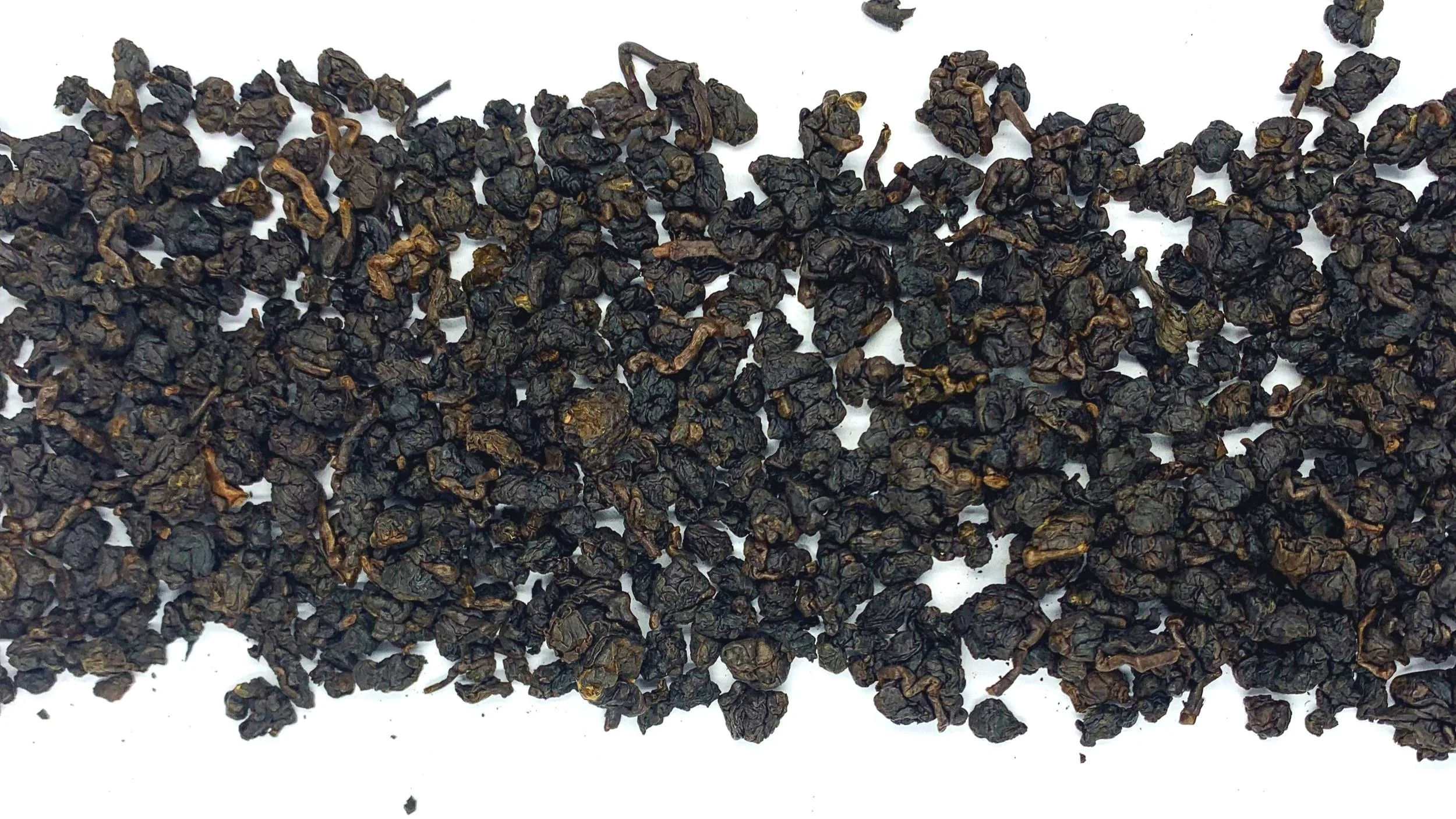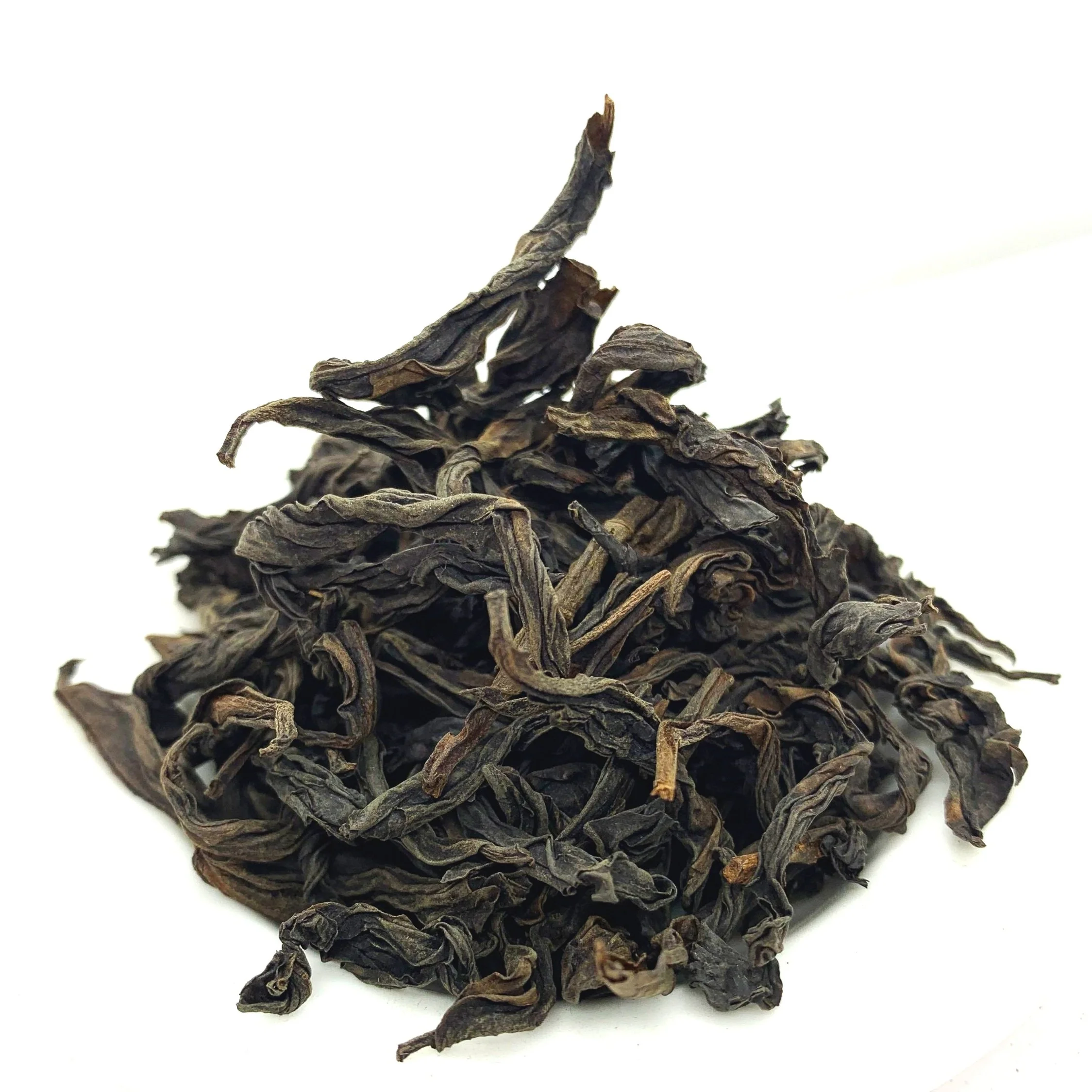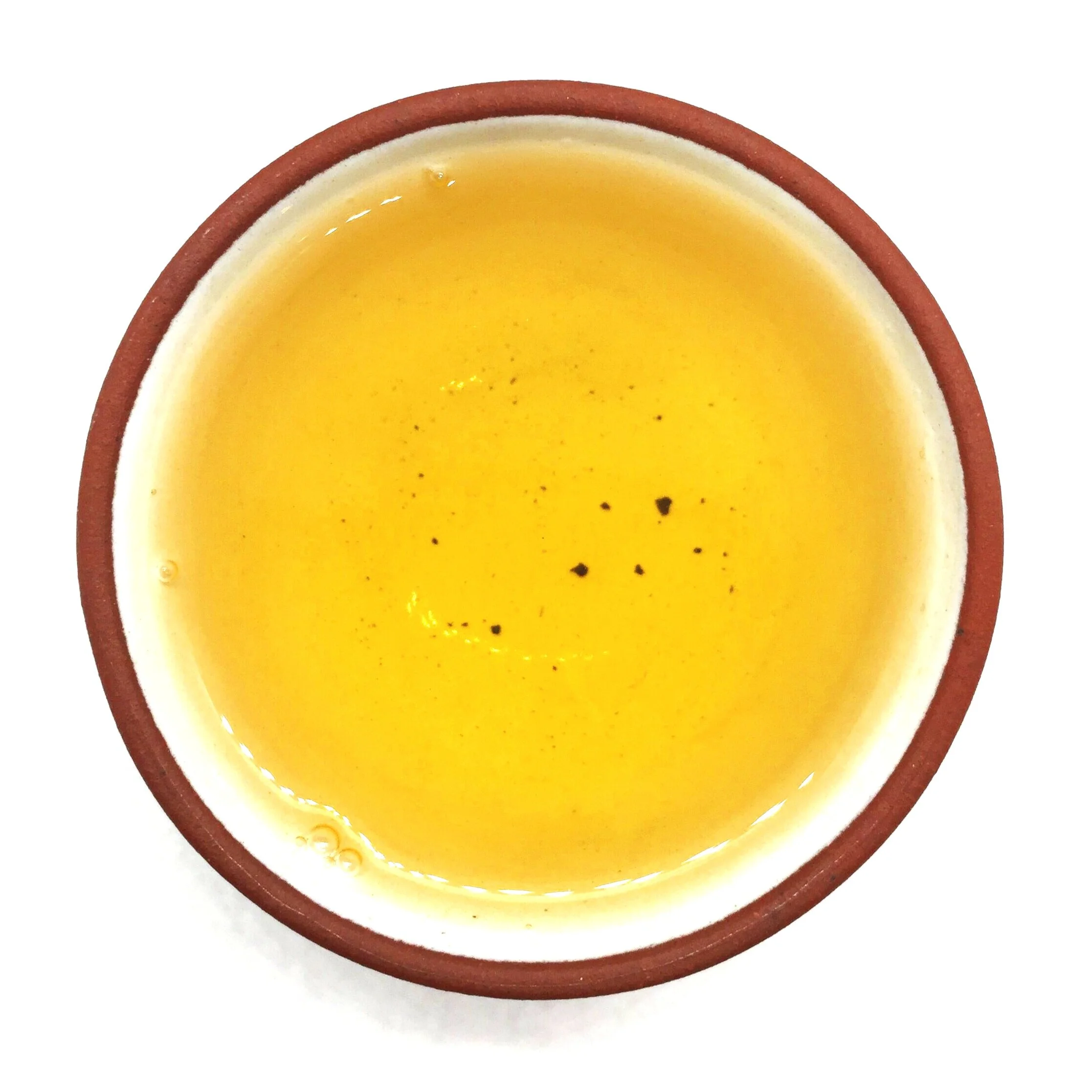Buddha's Hand
Buddha's Hand
Fo Shou or “Buddha’s Hand” is so-named for the plant’s large hand-sized leaves. The body of the tea is somewhat light, but bears a strikingly complex and aromatic flavor profile, with earthy and sour cave and dried grass notes supporting bouquets of stone-fruit and wild flowers. It has a subtle but powerful qi and rewards care and attention while brewing.
Teas from Wuyishan are highly sought after; the pristine and mineral-rich soil in which they grow, as well as the rich artisanal tradition which has developed around their crafting and consumption has led them to be considered one of China’s most famous teas. Because of the aggressive roasting that goes into creating these teas, it is best to let them rest for at least one year before consuming them. These teas may also be aged in dark and dry conditions in order to improve their flavor.
Origin - Wuyishan, Fujian, China
Harvest - 5/1/2020
Location - Da Shui Keng 大水坑, Zhengyan Area, Wuyi Mountain Scenic Area
Roast - 3 times, medium roast
Tastes Like - Ripe Pears, Dry Hay, Cave Rocks, Chrysanthemum
Sold in one ounce increments
The Name “Fo Shou” (佛手)
The name Fo Shou (佛手) is also the name used for the Chinese bergamot fruit plant which is an inedible citrus that has finger-like fruits. The full name for this tea in Chinese is “Yong Chun Fo Shou” (永春佛手), which translates to “Citron Buddha’s Hand.” As the bergamot fruit resembles the hand of a Buddha, so does the tea plant with its wide and thick leaves. Additionally, the dried mao cha (the un-refined tea before processing) are also said to resemble bergamot after they have been steeped, and the fragrance is notable like the citron fruit which is used for its scent. Because this tea plant is very precious, like gold, it is also sometimes called "Golden Buddha's Hand” (Jin Fo Shou 金佛手).
Main Production Areas
Fo Shou was mainly produced in Fujian in the mountains of Sukeng (苏坑), Yudou (玉斗), Jindou (锦斗), and Guiyang (桂洋) in Yongchun County (永春县), and Quanzhou City (泉州市). The tea was mostly grown at an altitude of 600 to 900 meters above sea level. Leaves are plucked from the tips of the Fo Shou tea trees to produce this famous product with a unique flavor among Fujian teas. In the 1980s Fo Shou along with other tea varietals were brought to the Wuyishan Mountains where they were grown and processed in the Yancha style. These teas are known as Pin Zhong teas as they originate outside of the Wuyishan area.
Fo Shou Varieties
There are two varieties of Fo Shou tea trees which are distinguished by the color of the trees' spring buds, and include Red Bud Fo Shou and Green Bud Fo Shou. The red bud variety is considered to be the best. The fresh leaves are as big as the palm of your hand, oval in shape, and have a thick mesophyll (inner tissue of the leaf). They sprout in late March and are harvested in mid-April. Fo Shou is picked in all four seasons, although spring tea accounts for 40% of the total. In Wuyishan only the Green Bud varietal is grown.
Origin Stories for Fo Shou
The legend of Fo Shou takes us back to the Northern Song Dynasty. A monk at Qihuyan Temple (骑虎岩寺) in Anxi County (安溪镇), southern Fujian, offered tea to Buddha as a part of his daily ritual. He carefully cultivated a particular tea that he had grafted from a tea plant that he found. After much careful cultivation, he was successful and produced an especially fragrant tea. He was so happy that he named this tea "Fo Shou" (Buddha’s Hand). Later, the monk passed it on to his disciples at the Shifengyan Temple (狮峰岩寺) in Yongchun County. To this day, tea farmers have competed in producing the best Fo Shou tea.
Wuyi Mountain Region
The Wuyi Mountains are located at the junction of Jiangxi and Northwest Fujian provinces in China. The region has a mild climate with an average temperature of 18-18.5°C, a long frost-free period, high humidity, and abundant rainfall. The mountains are shrouded in mist and fog all year round.
The most famous production area is the Zhengyan Mountain area (正岩茶区) which is located within the Wuyi Mountain Scenic Area (武夷山旅游风景区内). Since ancient times, the best tea of Wuyi has been said to come from the Zhengyan region. Particularly, the Zhengyan tea coming from the “Three Pits and Two streams” (三坑两涧) region is said to be the highest quality tea and includes tea from many high-altitude locations. The “Three Pits” are Hui Yuan Keng (慧苑坑), Nui Lan Keng (牛栏坑), Da Keng Kou (大坑口) while the “Two Streams” are Liu Xiang Jian (流香涧), and Wu Yuan Jian (悟源涧). The soil in the Zhengyan area contains a lot of sand and gravel creating soil with high permeability. The soil has high potassium and manganese content and moderate acidity. Here the daily temperature variation is small and the area is protected from cold winter winds.
Teas that are produced in the Bi Shi Yan (碧石岩), Ma Tou Yan (马头岩), Shi Zi Kou (狮子口), and Jiu Qu Xi (九曲溪) areas are usually known as Ban Yan Cha (半岩茶), literally meaning “half rock tea.” The tea from the Ban Yan region is lower altitude and not as sought-after as the Zhengyan tea. The soil in the Ban Yan region has low potassium content, high aluminum content, and high acidity.
Yan Yun 嚴韵
A signature feature of Wuyi Rock Tea is Yan Yun (嚴韵) which is often translated as “rock rhyme” or “mountain rhythm,” but perhaps is best understood as the essence of the tea. Often associated with the tea’s taste, it might be best thought of in a classical Chinese sense as the tea drinker’s experience of the tea as a sort of resonance with the mountains from which it came. Therefore it is more related to terroir than to characteristics resulting from processing or the tea variety itself, although of course one cannot be separated from the joint influence of all of these factors.
The origin of the term comes from a poem written in the eighteenth century by Emperor Qianlong (乾隆) called “Brewing Tea on a Winter Night” (冬夜烹茶). It is said that the gravely, sandy soil in Wuyi gives the tea a “rock bone flower fragrance” (骨花香岩). The “rock bones” (岩骨) are one of the main characteristics associated with yan yun - a feeling of the rock/mountain “cha qi” (茶氣), or tea energy, deep in your bones. Tea masters recognize the other main characteristics of yan yun as:
Xiang (香) “fragrance”: a clean and pure fragrance that is not sharp or too heavy, sometimes reminiscent of orchids.
Qing (清) “clear, pure”: the taste is refreshing and smooth, the tea liquor has a bright and clear color.
Gan (甘) “sweet”: the tea has a mellow sweet taste which is delicious with a sweet aftertaste, it is not overly bitter.
Huo (活) “lively”: the tea is vibrant and offers a unique feeling and tea drinking experience.
Ming Cong vs Pin Zhong
Wuyi tea can be divided into two categories: Ming Cong (名枞) and Pin Zhong (品种). The Ming Cong teas are traditional cultivars that have long histories and usually have some sort of legend or story associated with their name. Popular Ming Cong teas from Wuyi Mountain are Rou Gui (肉桂), Qi Dan (奇丹), Bei Dou (北斗), Shui Xian (水仙), Tie Lou Han (铁罗汉), Shui Jin Gui (水金龟), Ban Tian Yao (半天腰), and Bai Ji Guan (白鸡冠). Ming Cong teas have a strong cha qi (茶氣) or “tea energy,” and more body than Pin Zhong teas. They are usually baked to a medium or high degree.
Pin Zhong (品种) teas are varieties that were imported from other regions and/or hybridized in the 90s. Popular Pin Zhong teas include Huang Guan Yin (黄观音), Huang Mei Gui (黄玫瑰), Jin Mu Dan (金牡丹), Fo Shou (佛手), and Bai Rui Xiang (白瑞香), to name a few. Pin Zhong teas have various unique aromas and are usually roasted light or medium to preserve the aroma.
Wuyi Rock Tea Production Process
1. Selective Picking 开面采摘
Wuyi tea is best picked by experienced tea farmers. When picking, it is best to choose “one-tip three-leaf” (一芽三叶) or “one-tip four-leaf” (一芽四叶), rather than picking “one-tip two-leaf” (一芽两叶), because the latter leaves are too tender and easily break which would affect the resulting tea quality. Small-leaf varieties (小叶种) and medium-leaf (中叶种) varieties are the best for picking, whereas large-leaf varieties (大叶种) are considered inferior and generally avoided by tea growers.
2. Sun Fixation 晒青
Tea picking work is usually completed around 11:30 in the morning. After the picking, the tea leaves are transported in bamboo baskets to the tea factory to be withered in the sun (日光萎凋). This means that the tea leaves, after being picked, are usually set out in the sun to oxidize and reduce in water content. After the water partly evaporates using sun withering, the leaves will give off a nice scent. Usually set in the sun around 1 pm, if the sun is strong, the tea only needs to be left out to dry until 6-7 pm. Afterward, they can be spread out on bamboo sieves to cool down for 20- 30 minutes.
3. Laying and Tossing 做青/摇青
This step refers to the alternating processes of laying (or setting) and tossing.
Laying - the tea leaves are first put into a bamboo barrel machine and are heated with either bamboo or fruitwood charcoal to reduce the leaf moisture by about 10% making the leaves softer and the branches/stems less likely to fall off. The heating needs to be adjusted according to the freshness of the tea leaves. Generally, this step is complete after around 8-10 hours. After heating, the lid is open to let it stand so the tea can oxidize and cool down. This needs to be repeated two to three times before starting to toss.
Tossing - after heating and letting it stand to oxidize, the basket lid is closed and the baskets are rotated. Tossing allows the tea leaves to oxidize evenly. In the process of turning, the color of the edge of the tea leaves becomes red, and the color in the middle remains unchanged.
4. Stir Fixation 炒青
Continue to stir fry the leaves to reduce the moisture by another 20%. The temperature is around 176-232°F, and this step continues for about 7-10 minutes.
5. Rolling 揉捻
After stirring the tea leaves are rolled. The rolling gives the tea leaves their unique finished appearance. This process takes about 3-7 minutes.
6. Primary Roasting 初培
After the tea leaves are rolled into strands, they are spread out evenly. This process takes about 5-10 minutes.
7. Screening 筛分
The tea leaves are then screened, and the bad yellow flakes, branches, and stems will be removed, leaving only the good parts.
8. Re-Roasting 复培
The tea leaves are left to sit for about 15 days to remove harshness before they are re-roasted. The subsequent roastings are said to make the yan yun quality of the tea thicker. The various degrees of roasting can be divided into low fire, medium fire, and high fire. Low fire has the lightest flavor, medium fire is moderate, and high fire is the heaviest. Most people choose to drink tea that has been roasted at medium fire.





